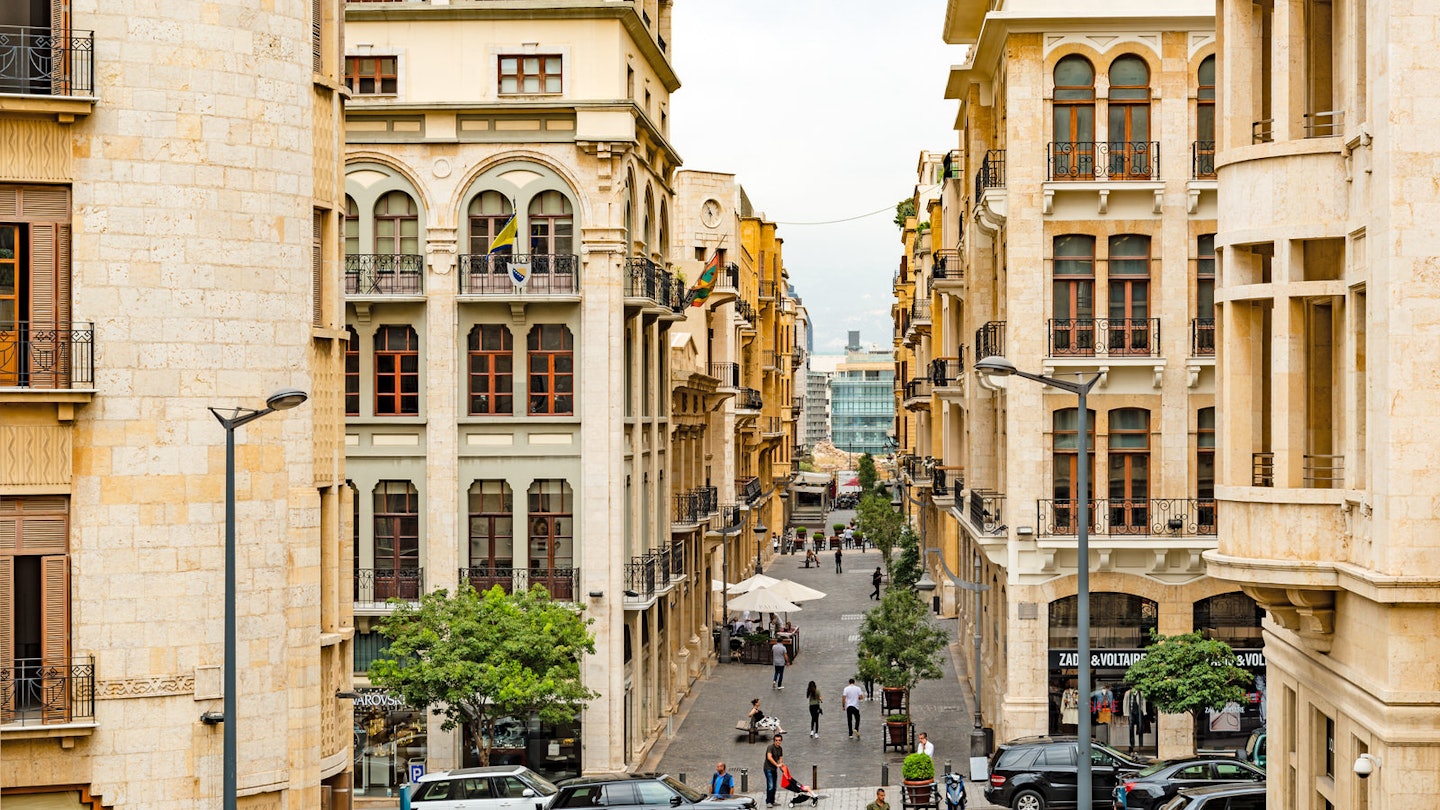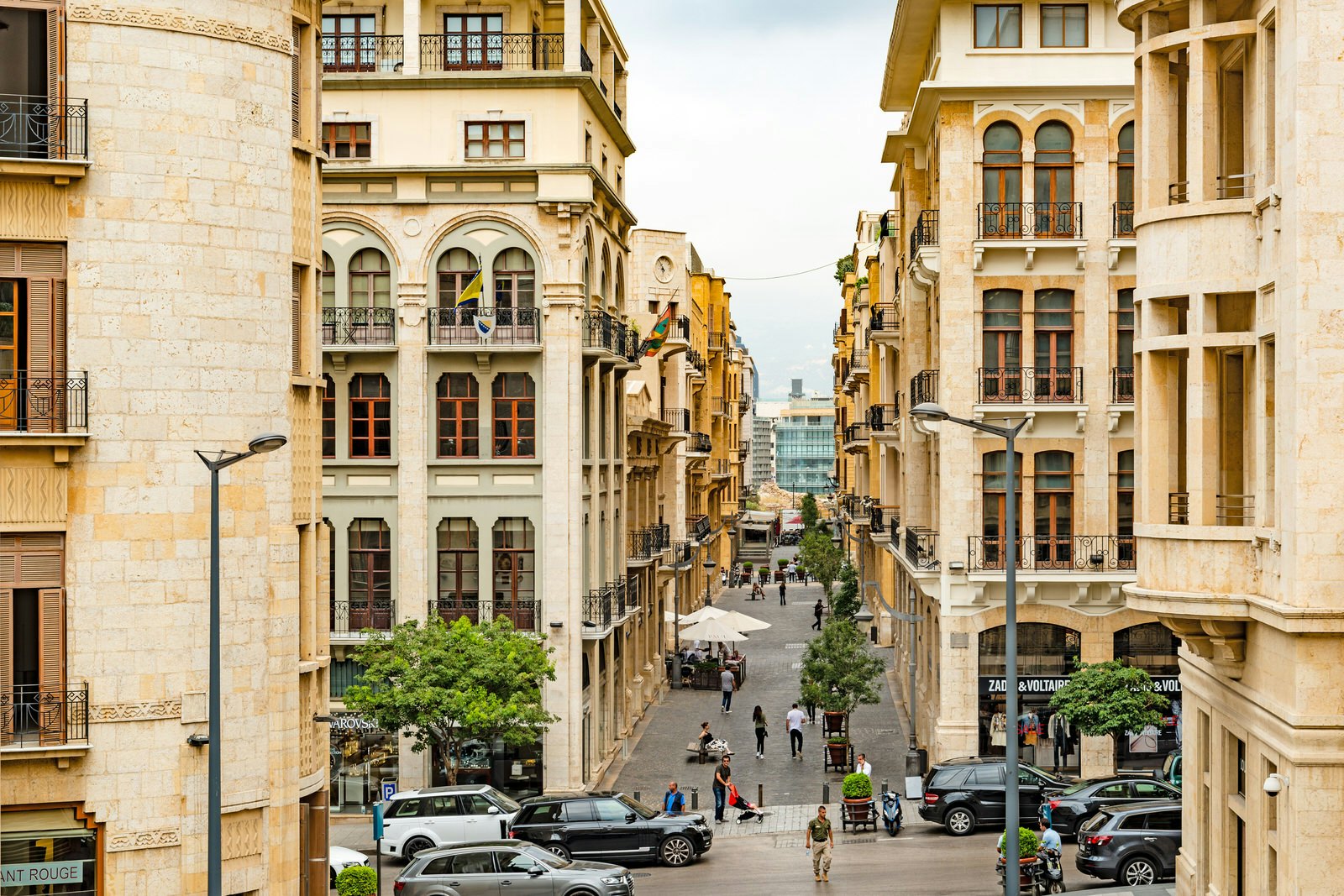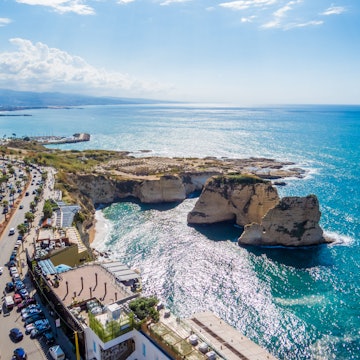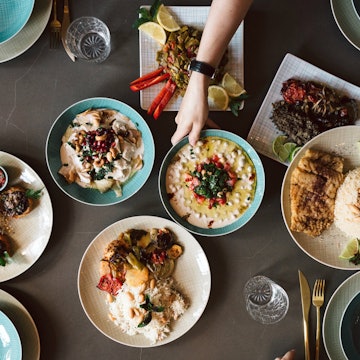

For a city with such a storied reputation, Beirut is geographically quite small. You can walk across it in about an hour, traversing districts of many confessions, former frontlines and myriad historical sites. The beauty of Beirut’s neighbourhoods is to be found by ambling, smelling the jasmine and stopping frequently for coffee with neighbourhood denizens.
Learn the phrase ahla w sahla – ‘welcome’ in English – you’ll hear it around every corner.

Hamra
Hamra is the bustling cultural heart of Beirut. It was here in the 1950s and '60s that Beirut first began its transformation from a provincial port of ancient ruins and sleepy souqs to the glamorous half-Mediterranean half-Middle Eastern capital it is today. In the 1960s, cafes drew intellectuals from the nearby American University of Beirut, who argued about radical politics and Palestine over cigarettes and espresso. The district was also the epicentre of Lebanon's first diverse arts scene, anchored by filmmakers leaving a changing Egypt and painters schooled in Europe’s ateliers. Today it’s nice to imagine the elderly men slowly ambling down Hamra St in dapper suits are just the leftists who never left.
Tour the leafy AUB campus for an afternoon (make sure to visit the university's excellent archaeological museum), pop into the bookshops on the main thoroughfare and then settle into a cafe like Mezyan or T Marbouta for a sundowner and a dinner of Lebanese mezze. If it’s a weekend, stick around Mezyan for live Arabic music and dancing that goes nearly all night.

Achrafiyeh
A fascinating mix of sleepy and uptight, Achrafiyeh is a charming antidote to energetic Hamra. Until the middle of the 20th century, Achrafiyeh was a patchwork of manor estates and shepherds’ paddocks. Many of the old houses have been demolished to make way for modern (some say soulless) high-rises, but that makes the discovery of a mouldering, vine-covered Ottoman-era palace at the end of a back alley all the sweeter. Check out 20th century Middle Eastern painting and decorative arts at the Sursock Museum, and be sure to peer through the gates at Sursock Palace across the street – it’s the best remaining example of an old Achrafiyeh house. Cross busy Charles Malek St to seek out sustenance in a delightfully confusing warren of winding streets (the Armenian restaurant Almayass is close by), and then come back toward Sursock St for an evening at Metropolis Sofil, Beirut’s only art-house cinema. Most of Achrafiyeh shuts down on Sundays.

Badaro
Badaro proper is one main road (Badaro St), and a few smaller, perpendicular streets that are peppered with bars and cafes. It’s pleasant enough to stop by for a drink or a meal, but to experience the best of this side of Beirut, venture outside the neighbourhood’s official borders. Beirut’s National Museum is worth a visit for its extensive collection of Phoenician artefacts (as well as an interesting look at how the museum protected its collection during the 15-year Lebanese civil war), as is Horsh Beirut, the big green park on the other end of Badaro St. A few hours at the Beirut Hippodrome watching the racehorses, followed by a sidewalk cuppa and a good book at Roy’s Public House is a relaxing way to while away a Sunday afternoon. If you fancy a slightly more raucous dalliance with Badaro, Attic, Troika, and Kissproof are compelling options for nights out.
Gemmayzeh
After having been one of the first east Beirut neighbourhoods to gentrify in the 2000s, Gemmayzeh went through a lull (when the spotlight shifted even further east to Mar Mikhaël) from which it’s only now bouncing back. Like many neighbourhoods in Beirut, Gemmayzeh is clustered around a long thoroughfare, Gouraud St, which runs from Martyrs Sq in Downtown until it conveniently turns into Armenia St, Mar Mikhaël’s main drag. Gemmayzeh is primarily a dining and drinking destination, with the exception of the excellent L’Artisan du Liban handicrafts shop, worth a visit for classy souvenirs. The neighbourhood has a lot to offer in the way of cheap and cheerful stalwarts of the dining scene, including Le Chef and Cafe Em Nazih for Lebanese mezze and good vibes. Drinking options also abound: frenetic nights out often begin or end at Torino Express, Gemmayzeh’s first bar and still one of its most interesting. For a more subdued daytime work session, the PYTs can be found at the Melbourne-style cafe Sip.

Mar Mikhaël
Mar Mikhaël happened fast. Six years ago, the neighbourhood was all refrigerator repair shops and tottering grandmothers getting in their gossip and vegetable shopping before retiring for the day at 11am. When the neon-lit bars and cool kids descended around 2012, the old people might have been stroppy, but they’re laughing now that apartment values have at least quadrupled. Since the genesis of today’s Mar Mikhaël, the bars on Armenia St have continuously slung cocktails and the ubiquitous local Almaza brew (Internazionale and Anise are popular watering holes). An interesting food and shopping scene has developed as well, especially in the alleys between Armenia St and the motorway. The neighbourhood looks good when the lights glitter at night, but a late afternoon stroll in the slanting Mediterranean sunlight is also recommended. A now quintessential Beirut itinerary is a stop at Plan Bey to peruse Lebanese prints and handicrafts, followed by dinner at Makan or Enab, and drinks on the strip.

Downtown
All roads in Beirut lead downtown (including an ancient Roman road from Damascus to the Mediterranean that terminated here, available for viewing in the centre of the district). Beirut’s old downtown was almost completely devastated during the 15-year civil war, which ended in 1990; since then, the area has been redeveloped into live-work buildings and luxury shops designed to lure petro-rich shoppers from the Gulf. The architecture is in an artfully distressed Italianate-Arabesque style that manages to be both trite and charming. Those interested in fashion should drop into Aïshti, Lebanon’s own luxury department store, to peruse international and local designer threads. There is also a lot here to interest ancient history buffs; aside from the Roman road, there are the remains of ancient Roman baths, as well as a fabulous little museum in the basement of the St George Greek Orthodox Church on the Place de l’Étoile that showcases the physical layers of historical settlement, from pre-Roman to Ottoman. Admire the Istanbul-lite exterior of the Mohammed Al Amin Mosque, but skip the musty and unexceptional interior. Finish your tour of downtown with a happy hour cocktail and a killer view at Iris, on the roof of the An Nahar building.






![Photo/File #: 12MP ..Country: Great Britain..Site: Hurst Castle..Caption: 12MP aerial..Image Date: [November 2021?]..Photographer: ExploringWithin MUST CREDIT..Provenance: Watch 2022](https://lp-cms-production.imgix.net/2022-03/GBR%20Hurst%20Castle%20MUST%20CREDIT.JPG?auto=format,compress&q=72&fit=crop&w=360&ar=1:1)






